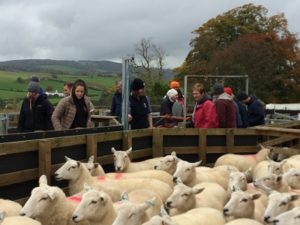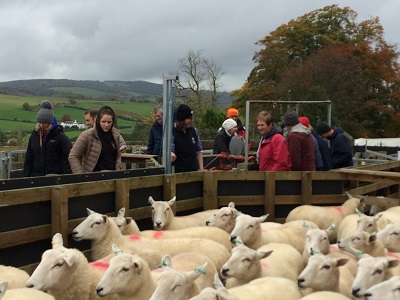Improving Efficiencies in Small Scale Sheep Production – Event Summary
14 October 2017Event held at Newlands Farm, Darvel, on 14th October 2017
An enthusiastic group of new and small scale sheep producers attended this event to learn how to improve their flock productivity. The workshop opened with a presentation covering a complete overview of sheep production (read the presentation slides here).
The next topic for discussion was the health and welfare, and how poor biosecurity can impact on the productivity of your sheep flock – read the presentation slides here.
The use of regular body condition scoring as a management tool was stressed and a practical session allowed everyone the chance to try the technique on ewes of varying condition scores. A body condition score of between 2.5 – 3.5 should be targeted at weaning, tupping and mid pregnancy to ensure the productivity of the sheep flock is not compromised. It takes approximately 8 weeks to modify 1 unit of Body condition score so early and frequent assessment is critical.
Pregnancy scanning is a useful tool to enable feed to be targeted to ewe requirements. Barren ewes can be removed from the flock saving on feed costs and feed can be prioritised to those carrying multiple lambs to ensure their nutrition requirements are adequately met avoiding the risk of an energy inbalance.
During the afternoon, fertility aspects of sheep production were discussed, linking with the effect these have on output. A ewe MOT should be carried out pre-tupping to ensure that only ewes fit for breeding are retained. Efficient culling of problem ewes can increase flock performance, by increasing lamb output, reducing lambing problems and the vet and med bill. The presentation slides from this discussion are available here.
Handouts provided during the event are available to download from the links below, and you can watch videos recorded from the event on our YouTube Channel.
- Technical Note (TN676): Why Tag and Record Sheep?
- If direct subsidies are claimed (Basic Payment Scheme, LFASS, Scottish Suckler Beef Support Scheme, Scottish Upland Sheep Support Scheme, Beef Efficiency Scheme and some SRDP options), adhering to Cross Compliance and Good Agricultural and Environmental Conditions (GAEC) is essential.
- Topics: Rural Business
- Liverfluke Products for Sheep & Cattle
- Biosecurity on sheep farms
- Topics: Livestock
- Ram Management booklet
- Topics: Climate Change and Livestock
- Practical Guide: Improving Ewe Efficiency (1)
- This Practical Guide looks at benchmarks to assess flock efficiency. Additional guides in this series focus on maximising performance both pre and post lambing.
- Topics: Climate Change
- Practical Guide: Improving Ewe Efficiency (2) – Pre Lambing
- This Practical Guide looks at maximizing performance within the flock, concentrating on pre lambing.
- Topics: Climate Change and Livestock
- Practical Guide: Improving Ewe Efficiency (3) – Meeting Benchmarks Post Lambing
- This Practical Guide looks at maximizing performance within the flock, concentrating on post lambing.
- Topics: Climate Change and Livestock
- QMS – Ewe nutrition and body condition scoring timeline
- A visual guide to ewe condition pre and post lambing.
- Topics: Climate Change and Livestock
- Year Round Feeding the Ewe for Lifetime Production
- Improved prices and better prospects for British lamb have lifted the industry and added value to any technical efficiency. The key to more and better lambs per ewe is proper feeding. We now know that proper nutrition, from as early in life as an embryo or even and egg, can affect a sheep’s lifetime performance.
- Topics: Climate Change
Sign up to the FAS newsletter
Receive updates on news, events and publications from Scotland’s Farm Advisory Service


